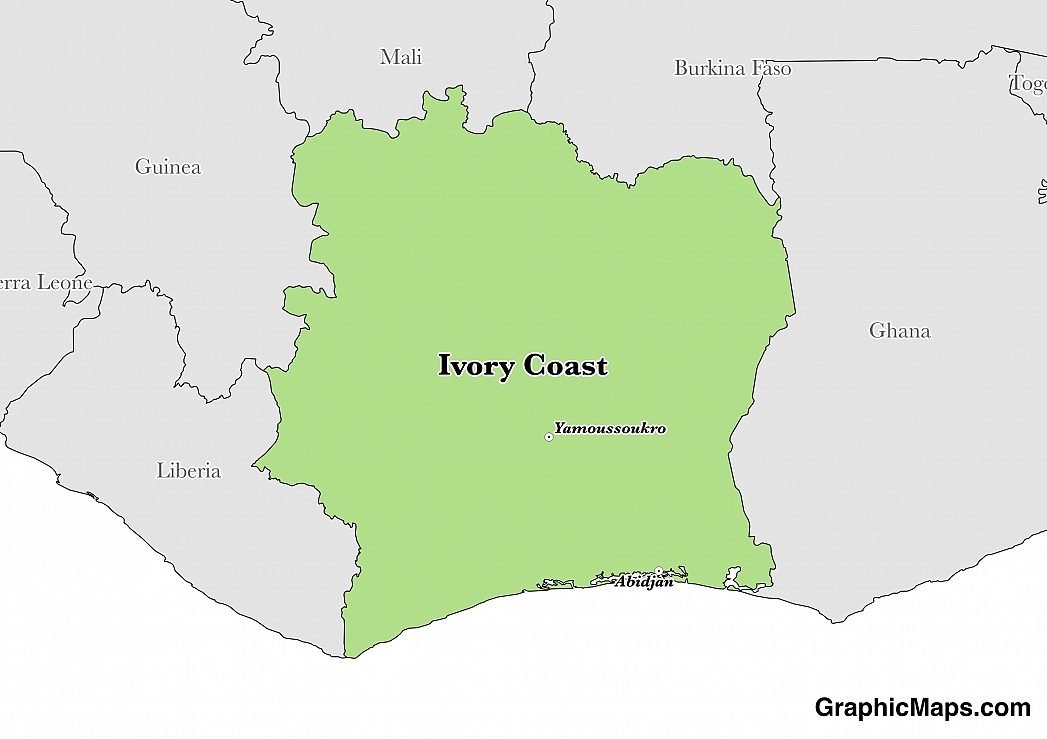Where is Ivory Coast?
Located in Western Africa, Ivory Coast has a 3,458.00 km border with Burkina Faso (545 km), Ghana (720 km), Guinea (816 km), Liberia (778 km) and Mali (599 km). It has a 515.00 km coastline. There is a dispute concerning the maritime border between Cote d'Ivoire and Ghana.
Yamoussoukro is the political and administrative capital city of Ivory Coast while Abidjan is considered the “economic” capital. It is located on South Central Ivory Coast. It was not until 1983 when Yamoussoukro was designated as the capital city of Ivory Coast. Before 1983, Abidjan served the capital. The city is not very populous; in fact, it is ranked fourth most populous city in Ivory Coast. As per the 2014 census in the country, the district has a population of approximately 355,000 inhabitants of which over 250,000 people live in within the city. The city is considered quiet with not so many activities going on along the street streets.
Read more on Ivory Coast's CapitalIvory Coast is an African country covering 322,463.00 km2 of which 1.38% is water and 318,003.00 km2 is land. This makes it the 68th largest country in the world and slightly larger than New Mexico. Its geographic coordinates are 8 00 N, 5 00 W and Yamoussoukro is the capital city.
The name Cote d'Ivoire refers to the history of ivory trade in the region.
Its ISO code is CI.
Geography
Ivory Coast has a mean elevation of 250 m above sea level.
It has a tropical climate along the coast, and a semiarid climate in the north of the country. Its terrain is mostly flat with some mountains in the northwest.
Population
Ivory Coast has a population of 23,740,424 making it the 54th largest in the world.
French is the official language. The major ethnic groups are Akan, Voltaique or Gur, and Northern Mande. The majority of the population is Muslim, with big Protestant and Catholic minorities.
The official and the national language of Ivory Coast is French. French is an Indo-European and Romantic language. The French alphabet has 26 letters. It uses the Latin Script in writing. French was introduced into Ivory Coast during the colonial era. Approximately 10 million people out of approximately 24 million living in Ivory Coast can comfortably sustain a conversation in the French language.
Read more on Ivory Coast's LanguagesThe dialing code for the country is 225.
Government
Ivory Coast is an independent country. It gained independent from France in 1960. Its constitution was last ratified in 2016.
Ivory Coast is a representative parliamentary democratic republic. It has a multi-party system with the president as the head of both the government and state. The parliament of the country is bi-cameral. It was initially unicameral until a constitutional referendum that upgraded it into a bicameral was passed in 2016. The National Assembly is the lower house whereas the Senate, which will be established during the next general elections will be the upper house of the parliament. The official residence of the president is referred to as the Presidential Palace. The elections in Ivory Coast are held after every five years with the several political parties competing for the available seats in the national assembly. The National Assembly constitutes of 225 members who are elected to represent constituencies
Read more on Ivory Coast's GovernmentEconomy
Factoring in Purchasing Power Parity, Ivory Coast's GDP is $87,120,000,000.00 (USD) with $3,600.00 (USD) per capita. This makes it the 87th largest economy and its citizens the 174th richest in the world. The currency of Ivory Coast is the Franc (XOF).
Its major export partners are the United States, the Netherlands, France, and Germany. Its main exports are cocoa, coffee, timber, petroleum, cotton, bananas, and pineapples. Its major import partners are Nigeria, China, France, and the Bahamas. Its major imports include fuel, capital equipment, and foodstuffs.
Flag
The Ivorian flag is a basic tricolor flag consisting of three equal vertical bands of orange, white, and green from the hoist to fly side respectively. The flag is modeled from the French tricolored flag, its former colonial power. The flag of Ivory Coast resembles the Irish flag, especially when hoisted on the reverse since the two flags both have orange, white, and green colors, except that the Irish flag is longer. The orange color on the Ivorian flag symbolizes the land, fertility, and the savannah which is in the northern part of the country. The white color symbolizes peace while the green color signifies the hope and forest cover on the southern part of the country. The Ivorian flag was adopted on December 3, 1959, following the referendum of the French Fifth Republic in 1958. The flag was retained without any alteration upon the country attaining independence on August 7, 1960. The Ivorian Flag is the first and the only flag the country has had. The tricolor French flag was mainly hoisted during colonization.
Read more on Ivory Coast's FlagThis page was last modified on January 17th, 2018
More on Graphicmaps

Published on 2019-11-06
What is a Trade Embargo?

Published on 2019-11-04
Which Two Countries Used to Have the Same Flag?

Published on 2019-09-16
What Is the Only Two-Sided State Flag?

Published on 2019-09-16
Which Country Flag Looks Like the Texas Flag?

Published on 2019-08-29
Flags That Resemble the US Flag

Published on 2019-08-20
